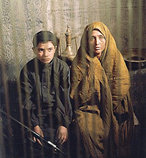 (A Girl Named) Osama
(A Girl Named) Osama
By: Jonas Cukierman
A young Afghan girl must pass herself off as a boy (Osama) to help her family after the Taliban http://www.hazara.net/taliban/taliban.html, closes the hospital where she and her mother work.
Along with the film Kandahar http://www.imdb.com/title/tt0283431/ , Osama is one of the most thorough depictions of how women are treated in a fanatical world where men are untouchable and laws are enforced at the whim of a few religious hardliners.
The locations and cinematography are a testimony to the time and place in which our characters evolve. As far as the eye can see, there exists a small village neck-deep in poverty, squalor, and the iron-fisted, looming shadow of the Taliban. There is not a subject more pervasive than this film as far as epitomizing the lack of women’s rights http://www.afghan-web.com/woman/ in a place where such basic entitlements as medical care are virtually nonexistent.
There is one scene in particular which is especially powerful in its own, unassuming way. While taking part in a wedding ceremony, a group of women’s festivities are cut short by the arrival of Taliban officials. As soon as they turn up, the veils go on, and the joyous adulations of celebration cleverly turn into cries and wails of a funeral rite.
Osama’s beauty as a film rests in its simplicity, as well as the character’s newfound self-awareness. Furthermore, the film’s allure is reflected in director Siddiq Barmak‘s http://en.wikipedia.org/wiki/Siddiq_Barmak, http://www.imdb.com/name/nm1383995/ use of contrasting colors. The saturated blues of the women’s garb are the flower in the cement garden of grey, dilapidated houses and crumbling walls into which the invisible, yet unmistakable presence of souls are felt; souls whose lives have been inextricable turned upside-down by war, famine, and hardship.
Audiences will hopefully be astonished at the richness of a people and their religious beliefs, which are fueled by frenetic radicalism on one hand, and a truly peaceful devotion to God on the other.
In the end, viewers and Osama are exposed to the bleak and unfortunate prospects reserved for women in such a dark period in Afghanistan’s history.
Soon after Osama’s real identity is discovered, she is married off to a man old enough to be her grandfather – and then some.
However, the bitter end is perhaps the most redeeming quality of the film. The fact we are, like Osama, the focus of a realistic ending is reason enough to ponder the history of how such patriarchal societies came into existence.
Images of director Siddiq Barmak and Osama:
http://www.google.com/images?q=siddiq+barmak&um=1&ie=UTF-8&source=univ&ei=TlAfTf_6D8ys8Abhh7jjCg&sa=X&oi=image_result_group&ct=title&resnum=3&ved=0CDkQsAQwAg&biw=1360&bih=677
http://www.google.com/images?q=siddiq+barmak&um=1&ie=UTF-8&source=univ&ei=TlAfTf_6D8ys8Abhh7jjCg&sa=X&oi=image_result_group&ct=title&resnum=3&ved=
0CDkQsAQwAg&biw=1360&bih=677
Images of the Taliban:
http://www.google.com/images?q=taliban&um=1&ie=UTF-8&source=univ&ei=xE0fTdXjKYP_8AaD2dTqDQ&sa=X&oi=image_result_group&ct=title&resnum=
10&ved=0CIkBELAEMAk&biw=1360&bih=677


(A girl named) Osama By: Jonas Cukierman By: Jonas Cukierman
Posted: January 1, 2011 in Film CommentaryTags: a man's world, Afghan Girl, Afghanistan, arranged marriage to much older man, assumed name, closing of women's hospital, girl posing as boy, Islamic Law, Kandahar, Osama, patriarchal society, Siddiq Barmak, Taliban, Women's rights
By: Jonas Cukierman
A young Afghan girl must pass herself off as a boy (Osama) to help her family after the Taliban http://www.hazara.net/taliban/taliban.html, closes the hospital where she and her mother work.
Along with the film Kandahar http://www.imdb.com/title/tt0283431/ , Osama is one of the most thorough depictions of how women are treated in a fanatical world where men are untouchable and laws are enforced at the whim of a few religious hardliners.
The locations and cinematography are a testimony to the time and place in which our characters evolve. As far as the eye can see, there exists a small village neck-deep in poverty, squalor, and the iron-fisted, looming shadow of the Taliban. There is not a subject more pervasive than this film as far as epitomizing the lack of women’s rights http://www.afghan-web.com/woman/ in a place where such basic entitlements as medical care are virtually nonexistent.
There is one scene in particular which is especially powerful in its own, unassuming way. While taking part in a wedding ceremony, a group of women’s festivities are cut short by the arrival of Taliban officials. As soon as they turn up, the veils go on, and the joyous adulations of celebration cleverly turn into cries and wails of a funeral rite.
Osama’s beauty as a film rests in its simplicity, as well as the character’s newfound self-awareness. Furthermore, the film’s allure is reflected in director Siddiq Barmak‘s http://en.wikipedia.org/wiki/Siddiq_Barmak, http://www.imdb.com/name/nm1383995/ use of contrasting colors. The saturated blues of the women’s garb are the flower in the cement garden of grey, dilapidated houses and crumbling walls into which the invisible, yet unmistakable presence of souls are felt; souls whose lives have been inextricable turned upside-down by war, famine, and hardship.
Audiences will hopefully be astonished at the richness of a people and their religious beliefs, which are fueled by frenetic radicalism on one hand, and a truly peaceful devotion to God on the other.
In the end, viewers and Osama are exposed to the bleak and unfortunate prospects reserved for women in such a dark period in Afghanistan’s history.
Soon after Osama’s real identity is discovered, she is married off to a man old enough to be her grandfather – and then some.
However, the bitter end is perhaps the most redeeming quality of the film. The fact we are, like Osama, the focus of a realistic ending is reason enough to ponder the history of how such patriarchal societies came into existence.
Images of director Siddiq Barmak and Osama:
http://www.google.com/images?q=siddiq+barmak&um=1&ie=UTF-8&source=univ&ei=TlAfTf_6D8ys8Abhh7jjCg&sa=X&oi=image_result_group&ct=title&resnum=3&ved=0CDkQsAQwAg&biw=1360&bih=677
http://www.google.com/images?q=siddiq+barmak&um=1&ie=UTF-8&source=univ&ei=TlAfTf_6D8ys8Abhh7jjCg&sa=X&oi=image_result_group&ct=title&resnum=3&ved=
0CDkQsAQwAg&biw=1360&bih=677
Images of the Taliban:
http://www.google.com/images?q=taliban&um=1&ie=UTF-8&source=univ&ei=xE0fTdXjKYP_8AaD2dTqDQ&sa=X&oi=image_result_group&ct=title&resnum=
10&ved=0CIkBELAEMAk&biw=1360&bih=677
Share this:
Related